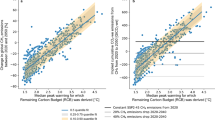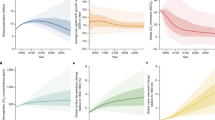Abstract
The Kyoto Protocol permits countries to meet part of their emission reduction obligations by cutting back on gases other than CO2 (ref. 1). This approach requires a definition of trade-offs among the radiatively active gases. The Intergovernmental Panel on Climate Change has suggested global warming potentials for this purpose2, which use the accumulated radiative forcing of each gas by a set time horizon to establish emission equivalence. But it has been suggested that this approach has serious shortcomings: damages or abatement costs are not considered3,4,5,6,7,8,9,10 and the choice of time horizon for calculating cumulative radiative force is critical, but arbitrary5. Here we describe an alternative framework for determining emission equivalence between radiatively active gases that addresses these weaknesses. We focus on limiting temperature change and rate of temperature change, but our framework is also applicable to other objectives. For a proposed ceiling, we calculate how much one should be willing to pay for emitting an additional unit of each gas. The relative prices then determine the trade-off between gases at each point in time, taking into account economical as well as physical considerations. Our analysis shows that the relative prices are sensitive to the lifetime of the gases, the choice of target and the proximity of the target, making short-lived gases more expensive to emit as we approach the prescribed ceiling.
This is a preview of subscription content, access via your institution
Access options
Subscribe to this journal
Receive 51 print issues and online access
$199.00 per year
only $3.90 per issue
Buy this article
- Purchase on Springer Link
- Instant access to full article PDF
Prices may be subject to local taxes which are calculated during checkout


Similar content being viewed by others
References
UNFCCC Kyoto Protocol to the United Nations Framework Convention on Climate Change (UNEP/INC/98/2, Information Unit for Conventions, UNEP, Geneva, 1998); http://www.unfccc.int/resource/docs/convkp/kpeng.pdf.
Schimel, D. et al. in Climate Change 1995: The Science of Climate Change 65–131 (eds Houghton, J. T. et al.) (Cambridge Univ. Press, Cambridge, 1996).
Eckaus, R. Comparing the effects of greenhouse gas emissions on global warming. Energy J. 13, 25–34 (1992).
Reilly, J. M. & Richards, K. R. Climate change damage and trace gas index issue. Environ. Res. Econ. 3, 41–61 (1993).
Schmalensee, R. Comparing greenhouse gases for policy purposes. Energy J. 14, 245–255 (1993).
Fankhauser, S. Valuing Climate Change – the Economics of the Greenhouse (EarthScan, London, 1995).
Kandlikar, M. The relative role of trace gas emissions in greenhouse abatement. Energy Policy 23, 879–883 (1995).
Hammitt, J. et al. A welfare based index for assessing environmental effects of greenhouse gas emissions. Nature 381, 301–303 (1996).
Tol, R. et al. Methane Emission Reduction: An Application of Funds 1–44(Institute for Environmental Studies, Vrije Universiteit, The Netherlands, 1999).
Reilly, J. et al. Multi-gas assessment of the Kyoto Protocol. Nature 401, 549–555 (1999).
Wuebbles, D. J., Jain, A. K., Patten, K. O. & Grant, K. E. Sensitivity of direct global warming potentials to uncertainties. Clim. Change 29, 265–297 (1995).
Climate Change Secretariat. United Nations Framework Convention on Climate Change 6 (UNEP/IUC, Geneva, 1992).
Peck, S. C. & Teisberg, T. J. Optimal carbon emission trajectories when damages depend on the rate or level of global warming. Clim. Change 28, 289–315 (1994).
Acknowledgements
We thank C. Gerlach and R. Parkin for research assistance. We have benefited from discussions with J. Aldy, J. Edmonds, L. Goulder, J. Reilly, R. Tol, J. Weyant, T. Wigley, L. Williams and T. Wilson. Funding was provided by EPRI.
Author information
Authors and Affiliations
Corresponding author
Rights and permissions
About this article
Cite this article
Manne, A., Richels, R. An alternative approach to establishing trade-offs among greenhouse gases. Nature 410, 675–677 (2001). https://doi.org/10.1038/35070541
Received:
Accepted:
Issue Date:
DOI: https://doi.org/10.1038/35070541
This article is cited by
-
Consequences of equivalency metric design for energy transitions and climate change
Climatic Change (2022)
-
Rethinking methane from animal agriculture
CABI Agriculture and Bioscience (2021)
-
Path to net zero is critical to climate outcome
Scientific Reports (2021)
-
Global Warming Potential Is Not an Ecosystem Property
Ecosystems (2021)
-
Asserting the climate benefits of the coal-to-gas shift across temporal and spatial scales
Nature Climate Change (2019)
Comments
By submitting a comment you agree to abide by our Terms and Community Guidelines. If you find something abusive or that does not comply with our terms or guidelines please flag it as inappropriate.



